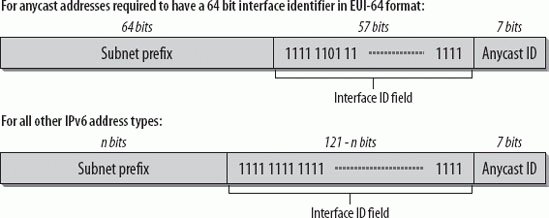Section 3.9. Anycast Address
3.9. Anycast AddressAnycast addresses are designed to provide redundancy and load balancing in situations where multiple hosts or routers provide the same service. Anycast was not created for IPv6; it was defined in RFC 1546 in 1993 as an experimental specification to be used with IPv4. The RFC allots a special prefix for anycast, which would make an anycast address recognizable as such based on the prefix. Anycast was meant to be used for services such as DNS and HTTP. The RFC discusses possible modifications to TCP to deal with these addresses that are not globally unique. In practice, anycast has not been implemented as it was designed to be. Often a method called shared unicast address is chosen. This method is implemented by assigning a regular unicast address to multiple interfaces and creating multiple entries in the routing table. In this case, the network and transport layer assume that it is a globally unique IP address. If it is not, the mechanism to deal with ambiguous addresses needs to be built into the application. An exception to this rule is if the application uses independent stateless request/reply transactionsfor instance, DNS over UDP. The root DNS servers in the Internet are set up using shared unicast addresses. As this procedure does not require any support from the network layer, it can also be used with IPv6. From the beginning, the IPv6 developers considered anycast to be incorporated in the network layer according to RFC 1546. No special prefix was assigned. IPv6 anycast addresses are in the same address range as global unicast addresses, and each participating interface must be configured to have an anycast address. Within the region where the interfaces containing the same anycast addresses are, each host must be advertised as a separate entry in the routing tables. If the anycast interfaces have no definable region, each anycast entry (in the worst case) has to be propagated throughout the Internet, which obviously does not scale. It is expected, therefore, that support for such global anycast addresses will be either unavailable or very restricted. Within one network where a group of routers can provide access to a common routing domain, they can be assigned a single address. When a client sends a packet to this address, it will be forwarded to the next available router. One example is the 6to4 relay anycast address that is specified in RFC 3068 and described in Chapter 10. The Mobile IPv6 specification also uses anycast addresses. When using anycast addresses, we have to be aware of the fact that the sender has no control over which interface the packet will be delivered. This decision is taken on the level of the routing protocol. When a sender sends multiple packets to an anycast address, the packets may arrive at different destinations. If there is a series of requests and replies or if the packet has to be fragmented, this may cause problems. The subnet-router anycast address , which is defined in RFC 4291 and shown in Figure 3-7, is a required anycast address. Figure 3-7. Format of the subnet-router anycast address Basically, the address looks like a regular unicast address with a prefix specifying the subnet and an identifier set to all zeros. A packet sent to this address will be delivered to one router on that subnet. All routers are required to support the subnet-router anycast address for subnets to which they have interfaces. RFC 2526 provides more information about anycast address formats and specifies other reserved subnet anycast addresses and IDs. A reserved subnet anycast address can have one of two formats, as shown in Figure 3-8. Figure 3-8. General format of anycast addresses RFC 2526 specifies that within each subnet, the highest 128 interface identifier values are reserved for assignment as subnet anycast addresses. Currently, the anycast IDs listed in Table 3-4 have been reserved.
The main difference between this form of using anycast and the shared unicast address is that in the latter, the application needs to support anycast, while in the former, this support is avoided if possible. Guidelines of how to use this and modifications to existing stateful transport protocols are needed. Draft-doi-ipv6-anycast-func-term-05.txt clarifies the usage of terms for IPv6 anycast and its outline. |